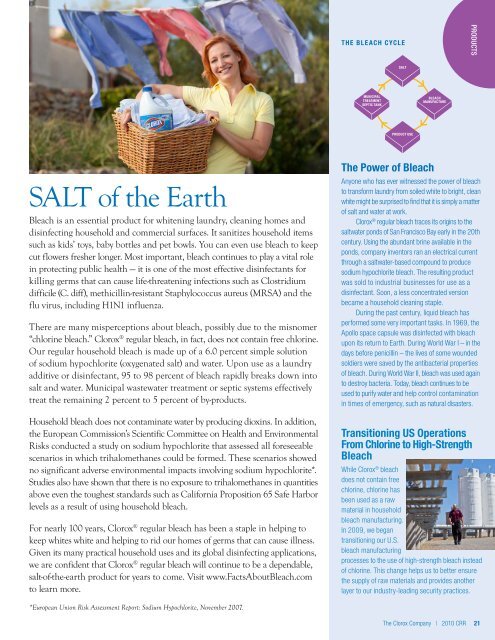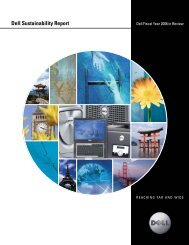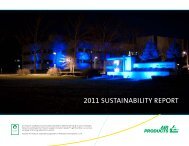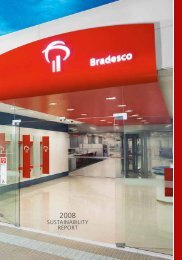English - The Clorox Company
English - The Clorox Company
English - The Clorox Company
Create successful ePaper yourself
Turn your PDF publications into a flip-book with our unique Google optimized e-Paper software.
THE BLEACH CYCLE<br />
PRODUCTS<br />
SALT<br />
MUNICIPAL<br />
TREATMENT<br />
SEPTIC TANK<br />
BLEACH<br />
MANUFACTURE<br />
PRODUCT USE<br />
SALT of the Earth<br />
Bleach is an essential product for whitening laundry, cleaning homes and<br />
disinfecting household and commercial surfaces. It sanitizes household items<br />
such as kids’ toys, baby bottles and pet bowls. You can even use bleach to keep<br />
cut flowers fresher longer. Most important, bleach continues to play a vital role<br />
in protecting public health — it is one of the most effective disinfectants for<br />
killing germs that can cause life-threatening infections such as Clostridium<br />
difficile (C. diff), methicillin-resistant Staphylococcus aureus (MRSA) and the<br />
flu virus, including H1N1 influenza.<br />
<strong>The</strong>re are many misperceptions about bleach, possibly due to the misnomer<br />
“chlorine bleach.” <strong>Clorox</strong> ® regular bleach, in fact, does not contain free chlorine.<br />
Our regular household bleach is made up of a 6.0 percent simple solution<br />
of sodium hypochlorite (oxygenated salt) and water. Upon use as a laundry<br />
additive or disinfectant, 95 to 98 percent of bleach rapidly breaks down into<br />
salt and water. Municipal wastewater treatment or septic systems effectively<br />
treat the remaining 2 percent to 5 percent of by-products.<br />
Household bleach does not contaminate water by producing dioxins. In addition,<br />
the European Commission’s Scientific Committee on Health and Environmental<br />
Risks conducted a study on sodium hypochlorite that assessed all foreseeable<br />
scenarios in which trihalomethanes could be formed. <strong>The</strong>se scenarios showed<br />
no significant adverse environmental impacts involving sodium hypochlorite*.<br />
Studies also have shown that there is no exposure to trihalomethanes in quantities<br />
above even the toughest standards such as California Proposition 65 Safe Harbor<br />
levels as a result of using household bleach.<br />
For nearly 100 years, <strong>Clorox</strong> ® regular bleach has been a staple in helping to<br />
keep whites white and helping to rid our homes of germs that can cause illness.<br />
Given its many practical household uses and its global disinfecting applications,<br />
we are confident that <strong>Clorox</strong> ® regular bleach will continue to be a dependable,<br />
salt-of-the-earth product for years to come. Visit www.FactsAboutBleach.com<br />
to learn more.<br />
<strong>The</strong> Power of Bleach<br />
Anyone who has ever witnessed the power of bleach<br />
to transform laundry from soiled white to bright, clean<br />
white might be surprised to find that it is simply a matter<br />
of salt and water at work.<br />
<strong>Clorox</strong> ® regular bleach traces its origins to the<br />
saltwater ponds of San Francisco Bay early in the 20th<br />
century. Using the abundant brine available in the<br />
ponds, company inventors ran an electrical current<br />
through a saltwater-based compound to produce<br />
sodium hypochlorite bleach. <strong>The</strong> resulting product<br />
was sold to industrial businesses for use as a<br />
disinfectant. Soon, a less concentrated version<br />
became a household cleaning staple.<br />
During the past century, liquid bleach has<br />
performed some very important tasks. In 1969, the<br />
Apollo space capsule was disinfected with bleach<br />
upon its return to Earth. During World War I – in the<br />
days before penicillin – the lives of some wounded<br />
soldiers were saved by the antibacterial properties<br />
of bleach. During World War II, bleach was used again<br />
to destroy bacteria. Today, bleach continues to be<br />
used to purify water and help control contamination<br />
in times of emergency, such as natural disasters.<br />
Transitioning US Operations<br />
From Chlorine to High-Strength<br />
Bleach<br />
While <strong>Clorox</strong> ® bleach<br />
does not contain free<br />
chlorine, chlorine has<br />
been used as a raw<br />
material in household<br />
bleach manufacturing.<br />
In 2009, we began<br />
transitioning our U.S.<br />
bleach manufacturing<br />
processes to the use of high-strength bleach instead<br />
of chlorine. This change helps us to better ensure<br />
the supply of raw materials and provides another<br />
layer to our industry-leading security practices.<br />
*European Union Risk Assessment Report: Sodium Hypochlorite, November 2007.<br />
<strong>The</strong> <strong>Clorox</strong> <strong>Company</strong> | 2010 CRR 21

















